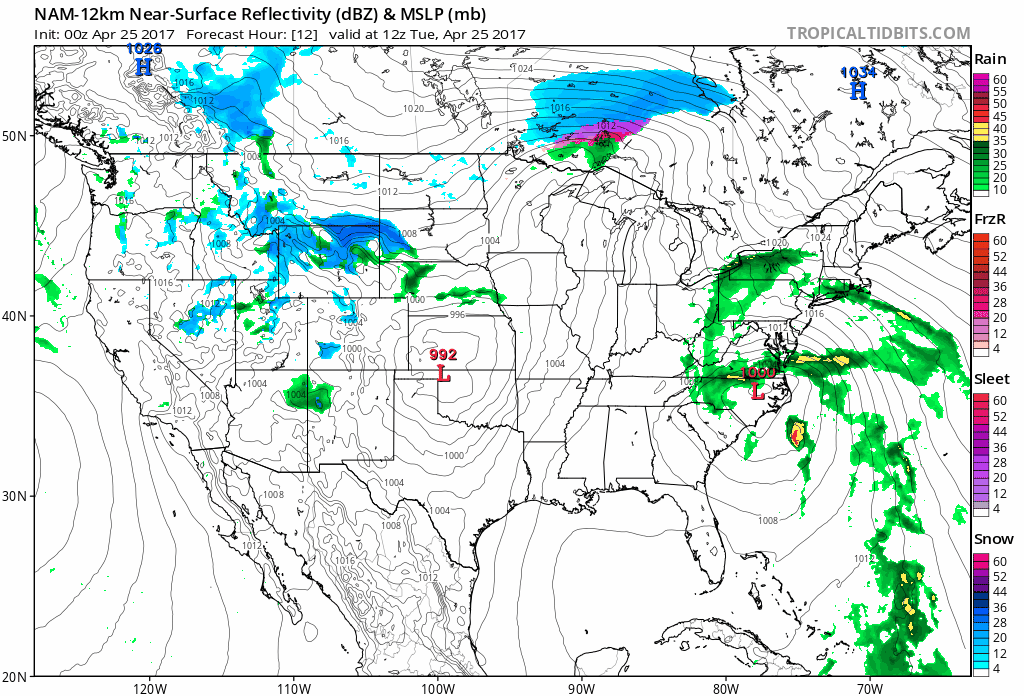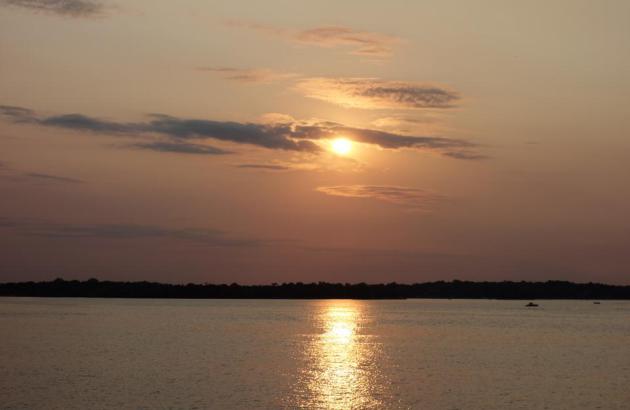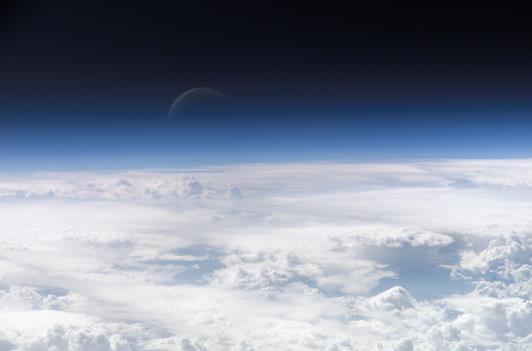72 F. high in the Twin Cities Monday.
62 F. average high on April 24.
62 F. high on April 24, 2016.
April 25, 1996: Heavy snow falls over northern Minnesota, including 10 inches of snow at Baudette. The International Falls Airport is forced to close for only the second time in history.

Cool and Soggy: Extended Outlook Calls for Disruption
“Grandpa, tell me again how people once told other people the weather forecast!” Is this a conversation I’m going to have in 15 years? Will humanoids be optional, computers so powerfully pervasive that meteorologists go the way of Betamax and 8-tracks?
I wish I knew, but there’s little doubt all of us will have to adapt to careers of lifelong learning. With robotics, automation and artificial intelligence half of all current white collar jobs may go away.
A century ago 41 percent of Americans were farmers; with mechanization only 2 percent of us farm today. How best to prepare for jobs that don’t even exist yet? We need smart strategies that prepare us for these coming (seismic) shifts.
Time for a little atmospheric pay-back after a postcard-weekend. A storm spinning up along the leading edge of chilly air keeps rain overhead from this afternoon into Wednesday; over an inch in some spots. Slushy snow mixes in over far northern counties, and I could even see some slushed-up lawns in the Twin Cities metro by Thursday morning. Whatever snow falls won’t stick around for long. A much higher sun angle will see to that.
Saturday almost looks tolerable but a cold rain returns on Sunday. Welcome to a cool, wet pattern. Spring takes a siesta until late next week.
P.S. The excitable guy above? He’s my replacement, coming sooner than I’d like. A little robotic in his gestures, but (much) smarter, slower to anger, better attitude, nicer disposition – and he never takes a vacation or asks for a raise. We should switch him over to decaf though. Or remove his battery.
Soaking Coastal Storm. Here’s a good overview of the slow-moving storm that pumped a fire-hose of Atlantic moisture into the Carolinas Monday, resulting in significant flooding. Details from the NOAA Environmental Visualization Laboratory: “A slow moving low pressure system will bring the threat for heavy rainfall, flash flooding, and a few strong to severe thunderstorms into Tuesday. The main threat areas include the southern Mid Atlantic and Southeast U.S. Excessive runoff may lead to flooding of low lying areas, rivers, and streams. This image was taken by GOES East at 1945 UTC on April 24, 2017.”

A Sloppy Pattern. Only the southwestern USA and immediate Gulf Coast is getting a break from puddles in the near future. Soaking rains spread into New England, while a storm spins up over the central Plains, spreading a cold rain into Minnesota and Wisconsin, ending as wet snow by Thursday across much of the Upper Midwest. More storms take aim at the Pacific Northwest, a familiar turn of events. 84-hour NAM guidance: NOAA and Tropicaltidbits.com.
Plowable Snowfall Minnesota Arrowhead and Northern Wisconsin? This is 3 KM NAM guidance, hinting at a few inches of slush for much of central Minnesota, especially Wednesday night into early Thursday. The model prints out a cool foot for the North Shore, with slush into the Twin Cities metro. Best chance of waking up to slushy lawns: Thursday morning.
March Relapse – Then Spring Returns Next Week. Wednesday and Thursday will be poignant reminders that April can bring splendor and pain, all in the same week. We may not climb out of the 40s Wednesday and Thursday; more 60s by the end of next week. The first weekend of May should feel like spring again. The sun is too high in the sky for it to stay chilly for long. ECMWF forecast for MSP: WeatherBell.
Like It Or Not Minnesota Is Trending Wetter. Climate guru Mark Seeley shared some statistics that made me do a double-take. Between 1941 and 1970 average annual precipitation in the Twin Cities was 25.93 inches. The most recent 30-year average (1981 to 2010) was 31.16 inches. Minnesota is warming roughly 2F a century and warmer air holds more water. Basic physics. So yes, odds favor more rain – in general.
The Big Picture. The atmosphere never moves in a straight line, but step back and look at the big picture and there’s no question Minnesota’s weather is becoming wetter with time. State precipitation trends above courtesy of the Minnesota Climatology Office and NOAA.
Portraits of the Earth-Moon System. The Atlantic has done a terrific job assembling some of the best photos of Earth and the Moon on one web link I’ve ever seen: “The Earth and its moon almost form a binary planet system. The moon is enormous—relative to the size of its planet—compared with the rest of the solar system. Since the 1960s, spacecraft and astronauts have been able to “step back” far enough to capture combined portraits of the Earth and its moon, separated by some 240,000 miles. Gathered below are some of the best of these portraits, some from as far away as 100 million miles...”
Image credit: NASA DSCOVR satellite. “Earth and the far side of the moon on July 5, 2016, also featuring Typhoon Nepartak over the Pacific Ocean, imaged by NASA’s Deep Space Climate Observatory (DSCOVR) satellite, about 1.5 million km (930,000 mi) from Earth.”
Map credit:
…Electric charging stations that offer a DC faster charger option can reduce that waiting time to around 30 minutes, but they can be difficult to find. Tesla owners, on the other hand, can easily find a nearby Supercharger on their massive touchscreen console. A Tesla Supercharger stations can restore 170 miles of range in just 30 minutes. As of late February, the company had 373 Supercharger stations in North America. It also had 805 stations worldwide with a total of 5,159 chargers. Tesla plans to double the number of Superchargers globally from roughly 5,000 to 10,000 worldwide. The company will add more than 1,000 Supercharger stations in California. Here’s a map of the new stations coming to North America (gray dots are new sites)...”
The Challenge of Our Disruptive Era. U.S. Senator Ben Sasse from Nebraska has an Op-Ed at The Wall Street Journal everyone should read: “…What’s happening now is wholly different. The rise of suburbia and exurbia, and the hollowing out of mediating institutions, is an echo of the changing nature of work. In the 1970s, it was common for a primary breadwinner to spend his career at one company, but now workers switch jobs and industries at a more rapid pace. We are entering an era in which we’re going to have to create a society of lifelong learners. We’re going to have to create a culture in which people in their 40s and 50s, who see their industry disintermediated and their jobs evaporate, get retrained and have the will and the chutzpah and the tools and the social network to get another job. Right now that doesn’t happen enough…”
Image credit: David Gothard.
Lilium: All-Electric, Vertical Take-Off and Landing Jet. Oh boy, it’s getting closer. Here’s an explainer from Lilium: “Lilium enables you to travel 5 times faster than a car by introducing the world’s first all-electric vertical take-off and landing jet: an air taxi for up to 5 people. You won’t have to own one, you will simply pay per ride and call it with a push of a button. It’s our mission to make air taxis available to everyone and as affordable as riding a car. In 1894, Otto Lilienthal began experimenting with the first gliders and imagined a future in which we could all fly wherever we want, whenever we want. Lilium is turning that dream into reality. We are bringing personalized, clean and affordable air travel to everyone.”

A Farewell to Skyways: The Case For Bringing Them Down. Are skyways sucking the vitality and long-term prospects out of our downtowns streets? Eric Dayton makes a convincing case in an Op-Ed at Star Tribune: “…We’re a 2017 city living with 1967 urban-design thinking, and it’s not working for us anymore. Why are the skyways so bad? Fundamentally, they rob our streets of the energy and vitality that come with foot traffic, the lifeblood of healthy retail. And that’s not just my opinion. It’s an assessment shared by every urban designer who has ever analyzed our city’s challenges. In 2007, the Downtown Council commissioned a report on our retail woes. The No. 1 factor identified was the bifurcation of foot traffic by the skyways. In response, we did nothing. We prefer to point the finger elsewhere, because it’s easier. The sad state of our retail is the Mall of America’s fault. Or online shopping is to blame. Or, most recently, it’s the Nicollet Mall construction. We’ve looked everywhere for the cause of our problems except in the mirror…”
My Husband and I Have Nothing in Common – and That’s Why our Relationship Works. Any truth to this? Or even just truthiness? Quartz has a curious story: “…Stephanie Coontz is a historian who’s spent decades researching and writing about marriage. It’s no exaggeration to say she’s the nation’s foremost authority on the institution; her work even influenced the Supreme Court’s ruling on marriage equality. When I called her to ask if it’s necessary for couples to have a wealth of interests in common, she was frank: “There’s no one magic tip for marriage. There is no single secret.” According to Coontz’s work, it’s only in the last 50 years or so that we’ve been marrying for love at all. “For thousands of years, marriage was more about gaining in-laws, channeling authority, and handling the tasks of daily life,” she said. “There was no sense you had a right to demand complete understanding from your partner...”
Photo credit: AP Photo/Invision/Antonio Pullano.
Prince Had 2,000 Pairs of Shoes – That We Know Of. Any why the heck not? We miss you Prince. Here’s an excerpt from Quartz: “…The team responsible for maintaining the mansion has cataloged 7,000 of the late musician’s belongings—and 2,000 of those are shoes. “Every outfit [tagged to far] had a matching pair of shoes,” Paisley Park’s archival director Angie Marchese, told the New York Times (paywall). “Most of them are ankle boots and have three-inch heels on them… Even his flip-flops were wedges. Even his tennis shoes are wedges.” Marchese described opening entire closets stuffed with footwear, and finding special pairs of shoes such as the teal set he wore at the 2007 Super Bowl, to match the uniform color of the Miami Dolphins, whose stadium the game was played at. And there are thousands of shoes because Prince rarely wore the same outfit twice. The team found 35 jackets and 35 pairs of pants from his 1984 “Purple Rain” tour alone…”
“Zen and The Art of Motorycle Maintenance” Author Robert M. Pirsig Dies at 88. I can’t tell you the influence this book had on me, like so many others who read it (multiple times). I heard a stat that only the Bible has sold more copies than this book. If you haven’t read it – do yourself a favor. It’s timeless. Here’s a clip from NPR: “…Zen was published in 1974, after being rejected by 121 publishing houses. “The book is brilliant beyond belief,” wrote Morrow editor James Landis before publication. “It is probably a work of genius and will, I’ll wager, attain classic status.” Indeed, the book quickly became a best-seller, and has proved enduring as a work of popular philosophy. A 1968 motorcycle trip across the West with his son Christopher was his inspiration…”
Photo credit: “Author Robert Pirsig and his son Chris in 1968. Pirsig, who wrote Zen and the Art of Motorcycle Maintenance, died Monday at age 88.” William Morrow/HarperCollins.
“Nothing is really ours until we share it.” – C.S. Lewis
March for Science. This is one of my favorite signs, courtesy of Twitter.
TODAY: Dry start. PM rain likely. Winds: NE 10-15. High: 63 (falling by afternoon)
TUESDAY NIGHT: Periods of rain, maybe heavy. Low: 44
WEDNESDAY: Rain mixes with wet snow. Fairly unpleasant. Winds: N 10-15. High: 46 (falling)
THURSDAY: Slushy start? Overcast and chilly, flurries. Winds: NW 8-13. Wake-up: 36. High: 42
FRIDAY: Mostly cloudy, still feels more like March. Winds: NW 8-13. Wake-up: 34. High: 52
SATURDAY: Clouds increase, better day of weekend. Winds: NE 8-13. Wake-up: 36. High: 53
SUNDAY: Chance of rain, fairly raw out there. Winds: NE 10-15. Wake-up: 39. High: 45
MONDAY: Damp start, then slow clearing, getting better. Winds: NW 8-13. Wake-up: 35. High: 58
Climate Stories….


What Americans Really Think About Climate Change. It seems a little like random violence – it will happen to someone else. There’s no way it can happen to me! Here’s an excerpt from The Atlantic: “…Climate change is a “stuck” issue in American politics. The polling continually points to a larger conclusion: Global warming is a highly partisan issue that most voters do not consider particularly significant to them, personally, even if they are worried about it. A Yale poll from last month put it starkly: More than 50 percent of Americans believe that climate change will “harm people in the United States,” but fewer than 40 percent of Americans believe it will “harm me, personally.” A lot of people know about climate change, and a lot of people think it is generally bad. But they do not change their votes because of it. Americans may change their vote because of economic fear, or defense policy, or to protect their property or social privileges. But they do not vote because the ice caps are melting. This is the heart of the climate issue…” (Image credit: NOAA NCDC).
Rising Sea to Displace 500,000 New Orleans Area Residents, Study Says – See Where They Might Go. Again, we already have climate refugees along the coast of New Orleans and Alaska. Here’s an excerpt from NOLA.com: “Texas, brace yourself. Over the next 83 years, a half-million southeast Louisiana “climate migrants” might be headed your way. A study published this week predicts that sea level rise will push hundreds of thousands of people out of U.S. coastal cities such as New Orleans. It says the population will boom in nearby inland cities such as Austin. The University of Georgia study is considered the first detailed look at how inland cities might be affected by sea level rise. It estimates more than than 500,000 people will flee the seven-parish New Orleans area by 2100 due to sea level rise and the problems that come with it, including frequent flooding and greater exposure to storm surges. That’s more than one third of metro New Orleans’s current population…”
Photo credit: “Pontchatoula residents flee rising waters in 2016. A new study predicts that thousands of Louisiana residents will be heading to Texas and other states to avoid rising sea levels over the next century.” (Photo by Ted Jackson, Nola.com | The Times-Picayune).
If You Live Inland, Don’t Think Sea Level Rise Won’t Affect You. With more perspective here’s a story link and excerpt at Ars Technica: “There has been a lot of talk about the millions of people worldwide whose homes will be at the mercy of rising sea levels. Within the US, a 1.8-meter rise in the oceans by 2100 could displace as many as 13.1 million people. Worldwide, up to 180 million people could be at risk. There has been less talk about where exactly those people will go when they leave their homes. Research on climate migration has painted sea level rise as “primarily a coastal issue,” writes Mathew E. Hauer in Nature Climate Change this week. But the inland regions that absorb climate change migrants will need to have sufficient transport, housing, and infrastructure to absorb the migrants...”
Photo credit: Richard at Flickr.
The Effects of Climate Change Will Force Millions to Migrate. Here’s What This Means for Human Security. The Washington Post has more insight on climate-related migration: “…Climate change is more than melting ice caps and swamped islands. The environmental effects of climate change — droughts, floods and severe weather, for instance — have increasingly put more people on the move. In 2015, the U.N. Refugee Agency counted 65.3 million people around the world as “forcibly displaced,” including about 40 million within their home countries. Wars, ethnic conflicts, economic stresses, famines and disasters are among the reasons people leave their homes. Less understood, perhaps, is how climate-induced environmental changes — such as increased flooding, desalinization, droughts or desertification — amplify these drivers of migration. What are the policy options to help people stay in place or minimize the security concerns related to migration? These questions are becoming more and more important to figure out...”
Photo credit: “A rescuer of the Malta-based Migrant Offshore Aid Station carries a migrant baby rescued from a wooden boat in the Mediterranean Sea off the coast of Sabratha in Libya this month.” (Darrin Zammit Lupi/Reuters)
More and More Fossil Fuel Companies Support a Carbon Tax – Here’s a Running List. Who would have predicted this a year or two ago? Here’s an excerpt from Quartz: “…Royal Dutch Shell ($233 billion) “If Trump does not go down the path of a carbon tax, we should not lose our resolve. We should stick to our values as Canadians to do something to protect the environment.” — Michael Crothers, President of Shell Canada, November 2016. “Carbon-pricing systems encourage the quickest and most efficient ways of reducing emissions widely.” — Ben van Beurden, CEO of Royal Dutch Shell, October 2015.
Exxon Mobil ($218 billion) “One option being discussed by policy makers is a national revenue-neutral carbon tax. This would promote greater energy efficiency and the use of today’s lower-carbon options, avoid further burdening the economy, and also provide incentives for markets to develop additional low-carbon energy solutions for the future.” — Darren Woods, CEO of Exxon Mobil, February 2017…”
Photo credit: “Stopping the tragedy of the commons.” (Reuters/Edgar Su)
On Earth Day, An Environment-Minded Republican Turns to Birds. Reuters has the story: “In his white dress shirt and black pin-striped pants, U.S. Representative Brian Fitzpatrick stood out from the other birdwatchers gathered near a grove of bud-studded trees in Bucks County, Pennsylvania, on Saturday morning. The National Audubon Society had invited the Republican congressman to the affluent town of New Hope on Earth Day for a glimpse at a few of the hundreds of millions of birds that travel to their breeding grounds during the spring migration. The society’s aim was to explain to Fitzpatrick the effects that global warming was having on the bright little jewels of spring and the habitats they pass through on their way north. “So many members of Congress are not with it on climate change, what we thought is, let’s take our local members of Congress birding and get them interested,” said Jim Greenwood, a trustee on National Audubon’s board, himself a former congressman…”
Photo credit: “U.S. Rep. Brian Fitzpatrick (R-PA), with Greg Goldman (L), executive director of Audubon Pennsylvania, tries to spot a red-winged blackbird while on a birdwatching tour hosted by the Audubon Pennsylvania in New Hope, Pennsylvania, U.S., April 22, 2017.” REUTERS/Emily Flitter.

When Climate Change Was Part of the Farm Bill. Remember when science wasn’t a political hot-potato? Here’s a clip from Christian Science Monitor: “…Agriculture Committee members heard about the struggling farm economy, crop insurance, and rural development. One issue that wasn’t discussed, despite its profound impact on farmers, is climate change. Both Republican House and Senate Agriculture Committee chairs are noted climate change skeptics. But Congress didn’t always have its head buried in the climate sand. The 1990 Farm Bill included a title called the Global Climate Change Prevention Act. That title established a program at the USDA to coordinate climate-related issues within the giant agency. The program was to “ensure that recognition for the potential for climate change is fully integrated into the research, planning, and decisionmaking processes of the Department.” This work included coordinating both inter-agency work as well as representing the USDA at the Intergovernmental Panel on Climate Change (IPCC), which had just been established in 1988. Specifically, the new climate change program was to study the impacts of climate change (including drought, extreme weather, new pests) on crop production and explore the potential for developing more climate-resilient crops...”

Solar-Powered Sermon. I want to thank Reverend Sarah Campbell the good people of Mayflower Church in South Minneapolis for their warm welcome and words of hope and encouragement. I gave the sermon yesterday, which was a first, a humbling undertaking at that. I presented the biblical case for climate justice, clean air, water and land; how we are all called to be stewards of God’s Creation. Mayflower Church installed solar panels 6-7 years ago – and a rough back-of-the-envelope calculation suggests a 20% savings on their electrical bill, to date. They are ahead of the curve, but when other churches discover they can save considerable money I suspect this clean, renewable-energy success story will multiply. Thank you!
Scientists: Get Used to Wildfires in a Warming World. Here’s a clip from a story at Climate Central: “…Yet homes and even whole communities still go up in flames, and there’s little indication that many efforts to reduce the risk have done much good, the study says. “Neither suppression nor current approaches to fuels management adequately reduce vulnerability of communities to increasing wildfire,” said the study’s lead author, Tania Schoennagel, a research scientist at the University of Colorado-Boulder’s Institute of Arctic and Alpine Research. “We’ve been very effective with fire suppression for many years, but wildfires are increasing beyond our capacity to control, especially with more people in fire’s way.” Park Williams, a bioclimatologist the Lamont-Doherty Earth Observatory at Columbia University, said the paper makes a valuable point: Forest density and climate change have converged to vastly increase catastrophic wildfire frequency and size in a way a that is entirely out of human control…”
Photo credit: “The 2016 Fort McMurray wildfire in eastern Alberta.” Credit: The Premier of Alberta/flickr.

